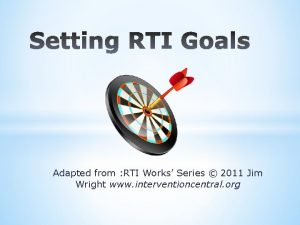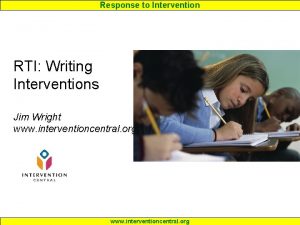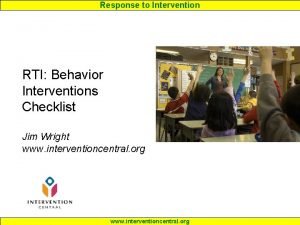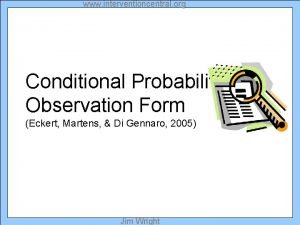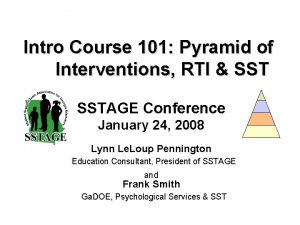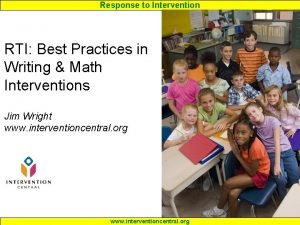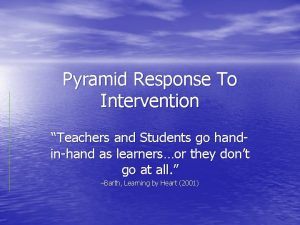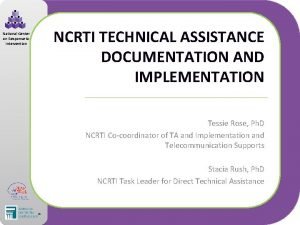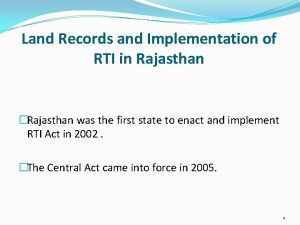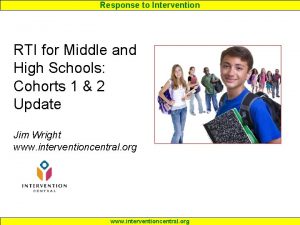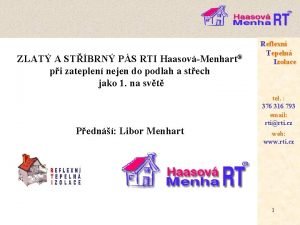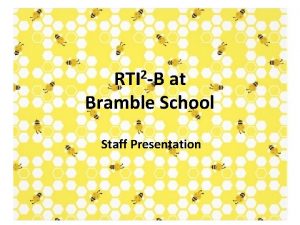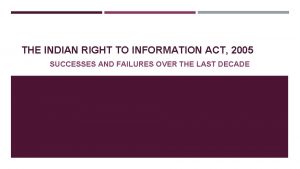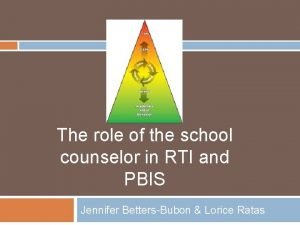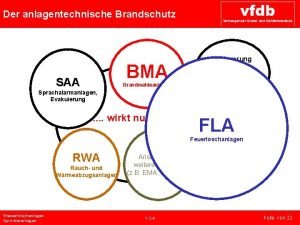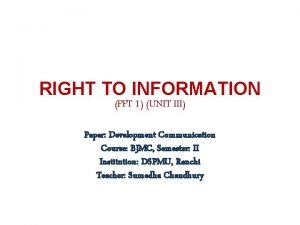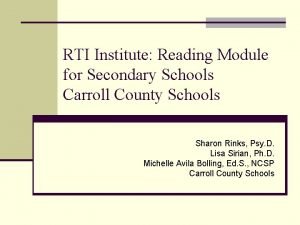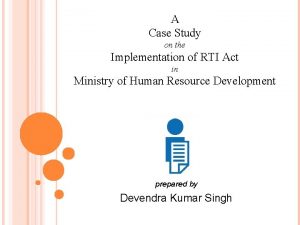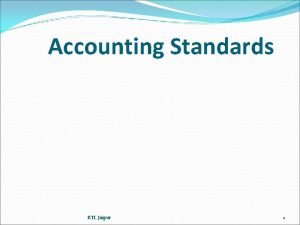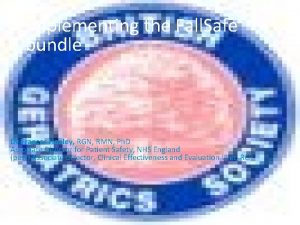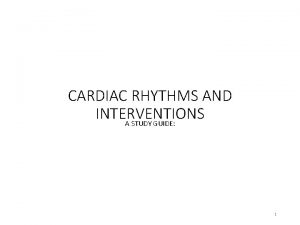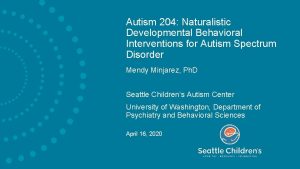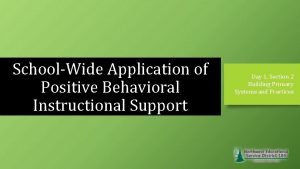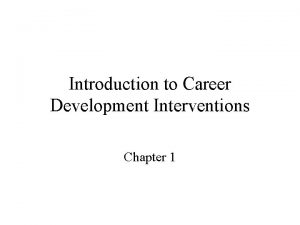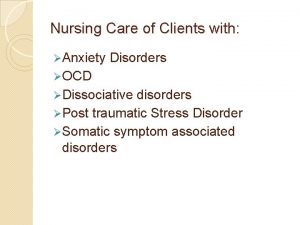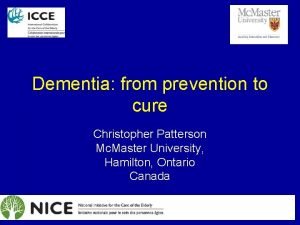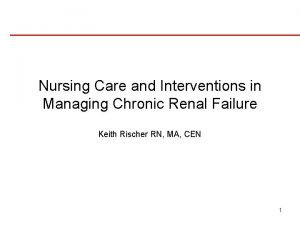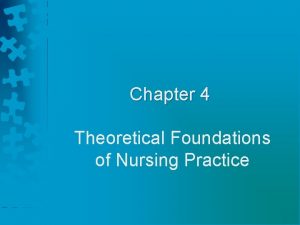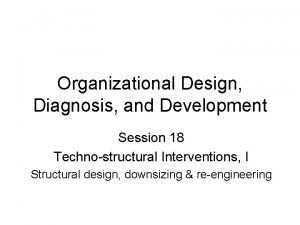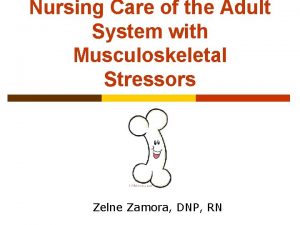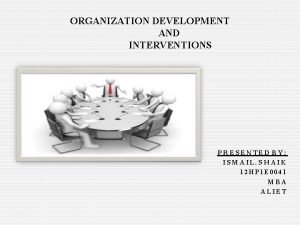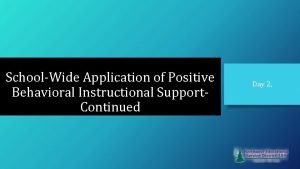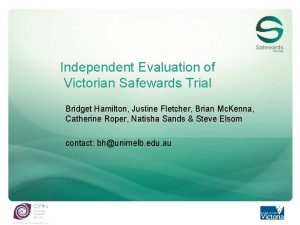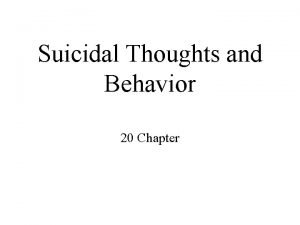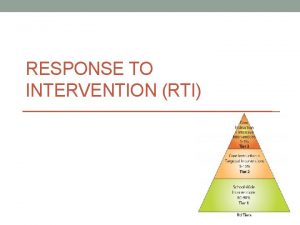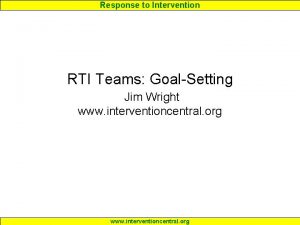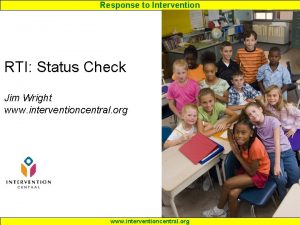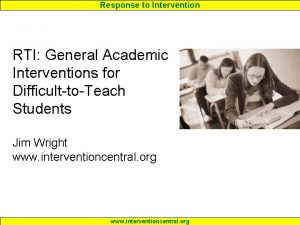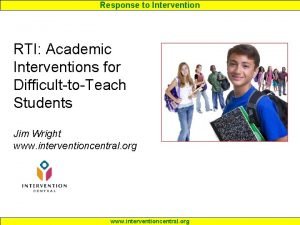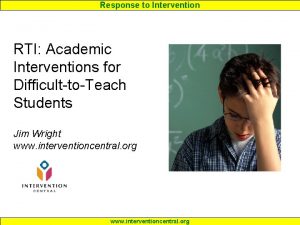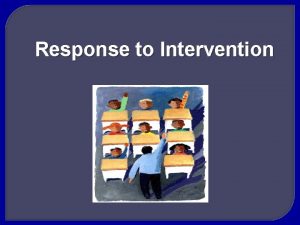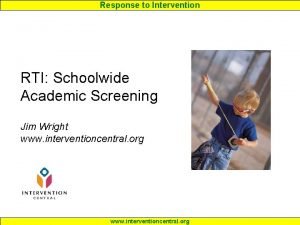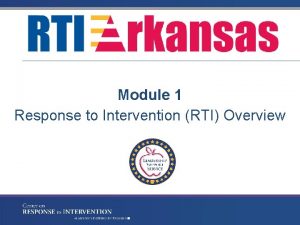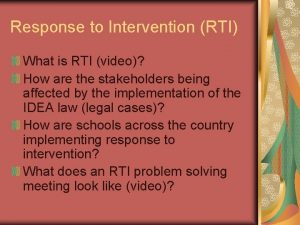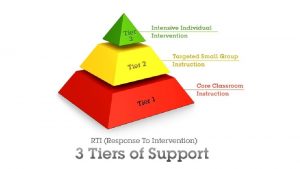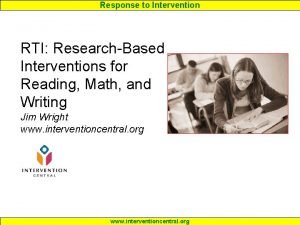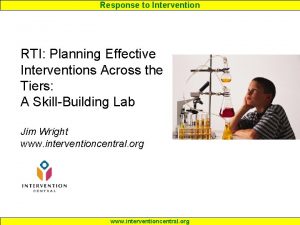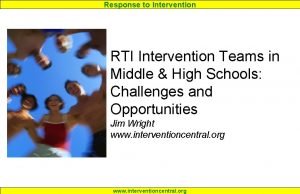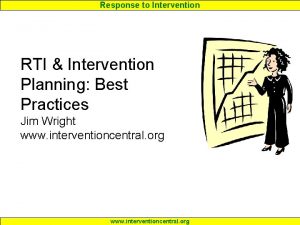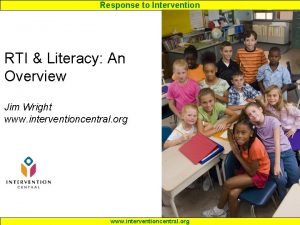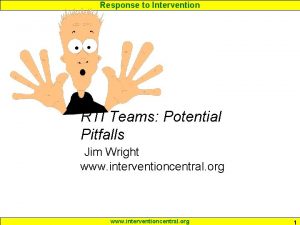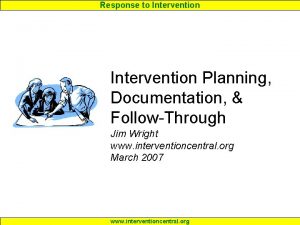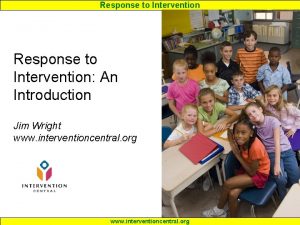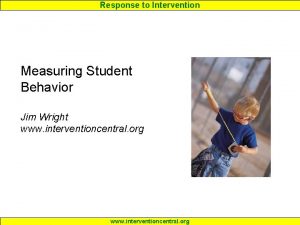Response to Intervention RTI Academic Interventions Jim Wright

































































- Slides: 65

Response to Intervention RTI: Academic Interventions Jim Wright www. interventioncentral. org

Response to Intervention RTI & Intervention: Key Concepts www. interventioncentral. org

Response to Intervention Essential Elements of Any Academic or Behavioral Intervention (‘Treatment’) Strategy: • Method of delivery (‘Who or what delivers the treatment? ’) Examples include teachers, paraprofessionals, parents, volunteers, computers. • Treatment component (‘What makes the intervention effective? ’) Examples include activation of prior knowledge to help the student to make meaningful connections between ‘known’ and new material; guide practice (e. g. , Paired Reading) to increase reading fluency; www. interventioncentral. org periodic review of material to aid 3

Response to Intervention Core Instruction, Interventions, Accommodations & Modifications: Sorting Them Out • Core Instruction. Those instructional strategies that are used routinely with all students in a general-education setting are considered ‘core instruction’. Highquality instruction is essential and forms the foundation of RTI academic support. NOTE: While it is important to verify that good core instructional practices are in place for a struggling student, those routine practices do not ‘count’ as individual student interventions. www. interventioncentral. org 4

Response to Intervention Core Instruction, Interventions, Accommodations & Modifications: Sorting Them Out • Intervention. An academic intervention is a strategy used to teach a new skill, build fluency in a skill, or encourage a child to apply an existing skill to new situations or settings. An intervention can be thought of as “a set of actions that, when taken, have demonstrated ability to change a fixed educational trajectory” (Methe & Riley-Tillman, 2008; p. 37). www. interventioncentral. org 5

Response to Intervention Core Instruction, Interventions, Accommodations & Modifications: Sorting Them Out • Accommodation. An accommodation is intended to help the student to fully access and participate in the general-education curriculum without changing the instructional content and without reducing the student’s rate of learning (Skinner, Pappas & Davis, 2005). An accommodation is intended to remove barriers to learning while still expecting that students will master the same instructional content as their typical peers. – Accommodation example 1: Students are allowed to supplement silent reading of a novel by listening to the book on tape. – Accommodation example 2: For unmotivated students, the instructor breaks larger assignments into smaller ‘chunks’ and providing students with www. interventioncentral. org 6

Response to Intervention Core Instruction, Interventions, Accommodations & Modifications: Sorting Them Out • Modification. A modification changes the expectations of what a student is expected to know or do—typically by lowering the academic standards against which the student is to be evaluated. Examples of modifications: – Giving a student five math computation problems for practice instead of the 20 problems assigned to the rest of the class – Letting the student consult course notes during a test when peers are not permitted to do so www. interventioncentral. org – Allowing a student to select a much easier book for a 7

Response to Intervention Improving the Integrity of Academic Interventions Through a Critical-Components ‘Pre-Flight’ Check Jim Wright www. interventioncentral. org

Response to Intervention Academic Interventions ‘Critical Components’ Checklist www. interventioncentral. org 9

Response to Intervention Academic Interventions ‘Critical Components’ Checklist This checklist summarizes the essential components of academic interventions. When preparing a student’s Tier 1, 2, or 3 academic intervention plan, use this document as a ‘pre -flight checklist’ to ensure that the academic intervention is of high quality, is sufficiently strong to address the identified student problem, is fully understood and supported by the teacher, and can be implemented with integrity. NOTE: While the checklist refers to the ‘teacher’ as the interventionist, it can also be used as a guide to ensure the quality of interventions implemented by nonwww. interventioncentral. org 10

Response to Intervention Allocating Sufficient Contact Time & Assuring Appropriate Student-Teacher Ratio The cumulative time set aside for an intervention and the amount of direct teacher contact are two factors that help to determine that intervention’s ‘strength’ (Yeaton & Sechrest, 1981). Critical Item? Intervention Element Time Allocated. The time set aside for the intervention is appropriate for the type and level of student problem (Burns & Gibbons, 2008; Kratochwill, Clements & Kalymon, 2007). When evaluating whether the amount of time allocated is adequate, consider: Length of each intervention session. Frequency of sessions (e. g. . , daily, 3 times per week) Duration of intervention period (e. g. , 6 instructional weeks) Student-Teacher Ratio. The student receives sufficient contact from the teacher or other person delivering the intervention to make that intervention effective. NOTE: Generally, www. interventioncentral. org Notes

Response to Intervention Matching the Intervention to the Student Problem Academic interventions are not selected at random. First, the student academic problem(s) is defined clearly and in detail. Then, the likely explanations for the academic problem(s) are identified to understand which intervention(s) are likely to help—and which should be avoided. Critical Item? Intervention Element Notes Problem Definition. The student academic problem(s) to be addressed in the intervention are defined in clear, specific, measureable terms (Bergan, 1995; Witt, Van. Der. Heyden & Gilbertson, 2004). The full problem definition describes: Conditions. Describe the environmental conditions or task demands in place when the academic problem is observed. Problem Description. Describe the actual observable academic behavior in which the student is engaged. Include rate, accuracy, or other quantitative information of student performance. Typical or Expected Level of Performance. Provide a typical or expected performance criterion for this skill or behavior. Typical or expected academic performance can be calculated using a variety of sources, www. interventioncentral. org

Response to Intervention www. interventioncentral. org 13

Response to Intervention Matching the Intervention to the Student Problem (Cont. ) Critical Item? Intervention Element Notes Appropriate Target. Selected intervention(s) are appropriate for the identified student problem(s) (Burns, Van. Der. Heyden & Boice, 2008). TIP: Use the Instructional Hierarchy (Haring et al. , 1978) to select academic interventions according to the four stages of learning: Acquisition. The student has begun to learn how to complete the target skill correctly but is not yet accurate in the skill. Interventions should improve accuracy. Fluency. The student is able to complete the target skill accurately but works slowly. Interventions should increase the student’s speed of responding (fluency) as well as to maintain accuracy. Generalization. The student may have acquired the target skill but does not typically use it in the full range of appropriate situations or settings. Or the student may confuse the target skill with ‘similar’ skills. Interventions should get the student to use the skill in the widest possible range of settings and situations, or to accurately discriminate between the target skill and ‘similar’ skills. Adaptation. The student is not yet able to modify or adapt an existing skill to fit novel task-demands or situations. Interventions should help the student to identify key concepts or elements from previously learned skills that can be adapted to the new demands or situations. www. interventioncentral. org

Response to Intervention Matching the Intervention to the Student Problem (Cont. ) Critical Item? Intervention Element ‘Can’t Do/Won’t Do’ Check. The teacher has determined whether the student problem is primarily a skill or knowledge deficit (‘can’t do’) or whether student motivation plays a main or supporting role in academic underperformance (‘wont do’). If motivation appears to be a significant factor contributing to the problem, the intervention plan includes strategies to engage the student (e. g. , high interest learning activities; rewards/incentives; increased student choice in academic assignments, etc. ) (Skinner, Pappas & Davis, 2005; Witt, Van. Der. Heyden & Gilbertson, 2004). www. interventioncentral. org Notes

Response to Intervention Activity: Matching the Intervention to the Student Problem • Consider these critical aspects of academic intervention: q Clear and specific problem-identification statement (Conditions, Problem Description, Typical/Expected Level of Performance). q Appropriate intervention target (e. g. , selected intervention is appropriately matched to Acquisition, Fluency, Generalization, or Adaptation phase of Instructional Hierarchy). q Can’t Do/Won’t Do Check (Clarification of whether motivation plays a significant role in student academic underperformance). www. interventioncentral. org

to Intervention Incorporating Effective. Response Instructional Elements These effective ‘building blocks’ of instruction are well-known and well-supported by the research. They should be considered when selecting or creating any academic intervention. Critical Item? Intervention Element Explicit Instruction. Student skills have been broken down “into manageable and deliberately sequenced steps” and the teacher provided“ overt strategies for students to learn and practice new skills” (Burns, Van. Der. Heyden & Boice, 2008, p. 1153). Appropriate Level of Challenge. The student experienced sufficient success in the academic task(s) to shape learning in the desired direction as well as to maintain student motivation (Burns, Van. Der. Heyden & Boice, 2008). Active Engagement. The intervention ensures that the student is engaged in ‘active accurate responding’ (Skinner, Pappas & Davis, 2005). at a rate frequent enough to capture student attention and to optimize effective learning. Performance Feedback. The student receives prompt performance feedback about the work completed (Burns, Van. Der. Heyden & Boice, 2008). Maintenance of Academic Standards. If the intervention includes any accommodations to better support the struggling learner (e. g. , preferential seating, breaking a longer assignment into smaller chunks), those accommodations do not substantially lower the academic standards against www. interventioncentral. org which the student is to be evaluated and are not likely to reduce the student’s Notes

Response to Intervention Activity: Incorporating Effective Instructional Elements • Think about the effective instructional elements reviewed in this workshop. • Incorporating Effective How can teachers ensure Instructional Elements that all effective instructional elements are included in academic interventions? Critical Item? Intervention Element Explicit Instruction. Appropriate Level of Challenge. Active Engagement. . Performance Feedback. Maintenance of Academic Standards. www. interventioncentral. org Notes

Response to Intervention Verifying Teacher Understanding & Providing Teacher Support The teacher is an active agent in the intervention, with primary responsibility for putting it into practice in a busy classroom. It is important, then, that the teacher fully understands how to do the intervention, believes that he or she can do it, and knows whom to seek out if there are problems with the intervention. Critical Item? Intervention Element Notes Teacher Responsibility. The teacher understands his or her responsibility to implement the academic intervention(s) with integrity. Teacher Acceptability. The teacher states that he or she finds the academic intervention feasible and acceptable for the identified student problem. Step-by-Step Intervention Script. The essential steps of the intervention are written as an ‘intervention script’--a series of clearly described steps—to ensure teacher understanding and make implementation easier (Hawkins, Morrison, Musti-Rao & Hawkins, 2008). Intervention Training. If the teacher requires training to carry out the intervention, that training has been arranged. Intervention Elements: Negotiable vs. Non-Negotiable. The teacher knows all of the steps of the intervention. Additionally, the teacher knows which of the intervention steps are ‘non-negotiable’ (they must be completed exactly as designed) and which are ‘negotiable’ (the teacher has some latitude in how to carry out those steps) (Hawkins, Morrison, Musti-Rao & Hawkins, 2008). www. interventioncentral. org

Response to Intervention Activity: Verifying Teacher Understanding & Providing Teacher Support In your teams: • Review the checklist for verifying that teachers understand all elements of the intervention and actively support its use. Verifying Teacher Understanding & Providing • How will your school ensure Critical Item? Support Intervention Element Teacher that teachers will Teacher Responsibility Teacher Acceptability. understand support Step-by-Step Intervention academic interventions Script. Intervention Training. designed to be implemented in Intervention Elements: the classroom? Negotiable vs. Nonwww. interventioncentral. org

Response Intervention Documenting the Intervention &to. Collecting Data Interventions only have meaning if they are done within a larger data-based context. For example, interventions that lack baseline data, goal(s) for improvement, and a progressmonitoring plan are ‘fatally flawed’ (Witt, Van. Der. Heyden & Gilbertson, 2004). Critical Item? Intervention Element Notes Intervention Documentation. The teacher understands and can manage all documentation required for this intervention (e. g. , maintaining a log of intervention sessions, etc. ). Checkup Date. Before the intervention begins, a future checkup date is selected to review the intervention to determine if it is successful. Time elapsing between the start of the intervention and the checkup date should be short enough to allow a timely review of the intervention but long enough to give the school sufficient time to judge with confidence whether the intervention worked. Baseline. Before the intervention begins, the teacher has collected information about the student’s baseline level of performance in the identified area(s) of academic concern (Witt, Van. Der. Heyden & Gilbertson, 2004). Goal. Before the intervention begins, the teacher has set a specific goal for predicted student improvement to use as a minimum standard for success (Witt, Van. Der. Heyden & Gilbertson, 2004). The goal is the expected student outcome by the checkup date if the intervention is successful. Progress-Monitoring. During the intervention, the teacher collects progressmonitoring data of sufficient quality and at a sufficient frequency to determine at www. interventioncentral. org

Response to Intervention Activity: Documenting the Intervention & Collecting Data In your teams: • Consider the elements of intervention documentation, data collection, and data interpretation discussed here. • Documenting the Intervention What steps can your school &take Collecting Data to make sure that data have Critical a Item? central focus when interventions are planned and implemented? Intervention Element Intervention Documentation. Checkup Date. Baseline. Goal. www. interventioncentral. org Notes

Response to Intervention References • • • Bergan, J. R. (1995). Evolution of a problem-solving model of consultation. Journal of Educational and Psychological Consultation, 6(2), 111 -123. Burns, M. K. , & Gibbons, K. A. (2008). Implementing response-to-intervention in elementary and secondary schools. Routledge: New York. Burns, M. K. , Van. Der. Heyden, A. M. , & Boice, C. H. (2008). Best practices in intensive academic interventions. In A. Thomas & J. Grimes (Eds. ), Best practices in school psychology V (pp. 11511162). Bethesda, MD: National Association of School Psychologists. Haring, N. G. , Lovitt, T. C. , Eaton, M. D. , & Hansen, C. L. (1978). The fourth R: Research in the classroom. Columbus, OH: Charles E. Merrill Publishing Co. Hawkins, R. O. , Morrison, J. Q. , Musti-Rao, S. , & Hawkins, J. A. (2008). Treatment integrity for academic interventions in real- world settings. School Psychology Forum, 2(3), 1 -15. Kratochwill, T. R. , Clements, M. A. , & Kalymon, K. M. (2007). Response to intervention: Conceptual and methodological issues in implementation. In Jimerson, S. R. , Burns, M. K. , & Van. Der. Heyden, A. M. (Eds. ), Handbook of response to intervention: The science and practice of assessment and intervention. New York: Springer. Skinner, C. H. , Pappas, D. N. , & Davis, K. A. (2005). Enhancing academic engagement: Providing opportunities for responding and influencing students to choose to respond. Psychology in the Schools, 42, 389 -403. Witt, J. C. , Van. Der. Heyden, A. M. , & Gilbertson, D. (2004). Troubleshooting behavioral interventions. A systematic process for finding and eliminating problems. School Psychology Review, 33, 363 -383. Yeaton, W. M. & Sechrest, L. (1981). Critical dimensions in the choice and maintenance of www. interventioncentral. org 23

Response to Intervention Activity: Using the Academic Interventions ‘Critical Components’ Checklist In your teams: • Discuss the Academic Interventions ‘Critical Components’ Checklist. • How might your school use this checklist to improve the quality of your building’s interventions at Tiers 1, 2, and 3? www. interventioncentral. org

Response to Intervention Assessing Intervention Integrity Jim Wright www. interventioncentral. org

Response to Intervention Why Assess Intervention Integrity? When a struggling student fails to respond adequately to a series of evidence-based interventions, that student is likely to face significant and potentially negative consequences, such as failing grades, long-term suspension from school, or even placement in special education. It is crucial, then, that the school monitor the integrity with which educators implement each intervention plan so that it can confidently rule out poor or limited intervention implementation of the intervention as a possible explanation for www. interventioncentral. org 26

Response to Intervention Integrity Check: Direct Observation Intervention integrity is best assessed through direct observation (Roach & Elliott, 2008). – The key steps of the intervention are defined and formatted as an observational checklist. – An observer watches as the intervention is conducted and checks off on the checklist those steps that were correctly carried out. The observer then computes the percentage of steps correctly carried out. www. interventioncentral. org 27

Response to Intervention Limitations of Direct Observation as an Intervention Integrity Check • Direct observations are time-consuming to conduct. • Teachers who serve as interventionists may at least initially regard observations of their intervention implementation as evaluations of their job performance, rather than as a childfocused RTI “quality check”. • An intervention-implementation checklist typically does not distinguish between--or differentially weight--those intervention steps that are more important from those that are less so. If two teachers implement the same 10 -step intervention plan, for example, with a critical step and the in Source: one Gansle, instructor K. A. , & Noell, G. H. omitting (2007). The fundamental role of intervention implementation assessing responseomitting to intervention. In S. fairly R. Jimerson, M. K. Burns, & A. M. Van. Der. Heyden (Eds. ), other a trivial step, both can still Response to intervention: The science and practice of assessment and intervention (pp. 244 -251). attain the same implementation score of steps www. interventioncentral. org 28

Response to Intervention ‘Yes/No’ Step-by-Step Intervention Check Each Step Marked ‘Negotiable or ‘Non. Negotiable’ Intervention Script Builder www. interventioncentral. org

Response to Intervention Supplemental Methods to Collect Data About Intervention Integrity Teacher Self-Ratings: As a form of selfmonitoring, directing interventionists to rate the integrity of their own interventions may prompt higher rates of compliance (e. g. , Kazdin, 1989). However, because teacher self-ratings tend to be ‘upwardly biased (Gansle & Noell, 2007, p. 247), they should not be relied upon as the sole rating of intervention integrity. One suggestion for collecting regular teacher reports on intervention implementation in a convenient manner is to use Daily Behavior Reports (DBRs; Chafouleas, Riley-Tillman, , & Sources: Chafouleas, S. , Riley-Tillman, T. C. , & Sugai, G. (2007). School-based behavioral assessment: Informing Sugai, 2007). intervention and instruction. New York: Guilford Press. Gansle, K. A. , & Noell, G. H. (2007). The fundamental role of intervention implementation in assessing response to intervention. In S. R. Jimerson, M. K. Burns, & A. M. Van. Der. Heyden (Eds. ), Response to intervention: The science and practice of assessment and intervention (pp. 244 -251). Kazdin, A. E. (1989). Behavior modification in applied settings (4 th ed. ). Pacific Gove, CA: Brooks/Cole. . www. interventioncentral. org 30

Response to Intervention Teacher Intervention Integrity Self. Rating Intervention Contact Log www. interventioncentral. org 31

Response to Intervention Supplemental Methods to Collect Data About Intervention Integrity Intervention Permanent Products: If an intervention plan naturally yields permanent products (e. g. , completed scoring sheets, lists of spelling words mastered, behavioral sticker charts), these products can be periodically collected and evaluated as another indicator of intervention integrity (Gansle Source: Noell, 2007). Gansle, & K. A. , & Noell, G. H. (2007). The fundamental role of intervention implementation in assessing response to intervention. In S. R. Jimerson, M. K. Burns, & A. M. Van. Der. Heyden (Eds. ), Response to intervention: The science and practice of assessment and intervention (pp. 244 -251). www. interventioncentral. org 32

Response to Intervention Integrity: Verify Through a Mix of Information Sources Schools should consider monitoring intervention integrity through a mix of direct and indirect means, including direct observation and permanent products (Gansle & Noell, 2007), as well as interventionist selfratings (Roach & Elliott, 2008). Source: Gansle, K. A. , & Noell, G. H. (2007). The fundamental role of intervention implementation in assessing response to intervention. In S. R. Jimerson, M. K. Burns, & A. M. Van. Der. Heyden (Eds. ), Response to intervention: The science and practice of assessment and intervention (pp. 244 -251). Roach, A. T. , & Elliott, S. N. (2008). Best practices in facilitating and evaluating intervention integrity. In A. Thomas & J. Grimes (Eds. ), Best practices in school psychology V (pp. 195 -208). www. interventioncentral. org 33

Response to Intervention ‘Selecting Methods to Track Intervention Integrity’… www. interventioncentral. org 34

Response to Intervention ‘Selecting Methods to Track Intervention Integrity’… www. interventioncentral. org 35

Response to Intervention ‘Selecting Methods to Track Intervention Integrity’… www. interventioncentral. org 36

Response to Intervention ‘Selecting Methods to Track Intervention Integrity’… www. interventioncentral. org 37

Response to Intervention Team Activity: Measuring ‘Intervention Follow. Through’ At your table: • Brainstorm ways that your RTI Team will use to measure intervention integrity for math and writing interventions. • What preparations are necessary to introduce these methods for measuring ‘intervention followthrough’ to your faculty? www. interventioncentral. org 38

Response to Intervention Building Team Activity: Map Out Tier 2/3 Programs In your elbow groups: • Review page 8 of the Planning Packet (Packet 6): RTI Plan: Element 3… Inventory Evidence. Based Supplemental Intervention Programs Available at Tiers 2 & 3 • Create an inventory of Tier 2/3 programs or services (academic or behavioral) at your school. www. interventioncentral. org 39

Response to Intervention Motivation Intervention: Case Example Jim Wright www. interventioncentral. org

Response to Intervention Case Example: Non-Compliance The Problem • Justin showed a pattern from the start of the school year of not complying with teacher requests in his English class. His teacher, Mr. Steubin, noted that – when given a teacher directive—Justin would sometimes fail to comply. Justin would show no obvious signs of opposition but would sit passively or remain engaged in his current activity, as if ignoring the instructor. When no task demands were made on him, Justin was typically a quiet and somewhat distant student www. interventioncentral. org 41

Response to Intervention Case Example: Non-Compliance The Evidence • Student Interview. Mr. Steubin felt that he did not have a strong relationship with the student, so he asked the counselor to talk with Justin about why he might be noncompliant in English class. Justin told the counselor that he was bored in the class and just didn’t like to write. When pressed by the counselor, Justin admitted that he could do the work in the class but chose not to. • Direct Observation. Mr. Steubin noted that Justin was less likely to comply with writing assignments than other in-class tasks. The likelihood that Justin would be non-compliant tended to go up if Mr. Steubin pushed him to comply in the presence of Justin’s peers. The odds that Justin would comply also appeared to increase when Mr. Steubin stated his request and walked away, rather than continuing to ‘nag’ www. interventioncentral. org 42

Response to Intervention Case Example: Non-Compliance The Evidence (Cont. ) • Work Products. Mr. Steubin knew from the assignments that he did receive from Justin that the student had adequate writing skills. However, Justin’s compositions tended to be short, and ideas were not always as fully developed as they could be—as Justin was doing the minimum to get by. • Input from Other Teachers. Mr. Steubin checked with other teachers who had Justin in their classes. The Spanish teacher had similar problems in getting Justin to comply but the science teacher generally found Justin to be a compliant and pleasant student. She noted that Justin seemed to really like hands-on activities and that, when potentially noncompliant, he responded well to gentle humor. www. interventioncentral. org 43

Response to Intervention Case Example: Non-Compliance The Intervention • Mr. Steubin realized that he tended to focus most of his attention on Justin’s non-compliance. So the student’s non compliance might be supported by teacher attention. OR the student’s compliant behaviors might be extinguished because Mr. Steubin did not pay attention to them. • The teacher decided instead that Justin needed to have appropriate consequences for non-compliance, balanced with incentives to engage in learning tasks. Additionally, Mr. Steubin elected to give the student attention at times that were NOT linked to non-compliance. www. interventioncentral. org 44

Response to Intervention Case Example: Non-Compliance The Intervention (Cont. ) • Appropriate Consequences for Non-Compliance. Mr. Steubin adopted a new strategy to deal with Justin’s episodes of non -compliance. Mr. Steubin got agreement from Justin’s parents that the student could get access to privileges at home each day only if he had a good report from the teacher about complying with classroom requests. Whenever the student failed to comply within a reasonable time (1 minute) to a teacher request, Mr. Steubin would approach Justin’s desk and quietly restate the request as a two-part ‘choice’ statement. He kept his verbal interactions brief and neutral in tone. As part of the ‘choice’ statement, the teacher told Justin that if he did not comply, his parents would be emailed a negative report. If Justin still did not comply, Mr. Steubin www. interventioncentral. org would follow through later that day in 45

Response to Intervention Teacher Command Sequence: Two-Part Choice Statement 1. Make the request. Use simple, clear language that the student understands. If possible, phrase the request as a positive (do) statement, rather than a negative (don’t) statement. (E. g. , “Justin, please start your writing assignment now. ”) Wait a reasonable time for the student to comply (e. g. , 1 minute) www. interventioncentral. org

Response to Intervention Teacher Command Sequence: Two-Part Choice Statement 2. [If the student fails to comply] Repeat the request as a 2 -part choice. Give the student two clear choices with clear consequences. Order the choices so that the student hears negative consequence as the first choice and the teacher request as the second choice. (E. g. , “Justin, I can email your parents to say that you won’t do the class assignment or you can start the assignment now and not have a negative www. interventioncentral. org

Response to Intervention Teacher Command Sequence: Two-Part Choice Statement 3. [If the student fails to comply] Impose the pre-selected negative consequence. As you impose the consequence, ignore student questions or complaints that appear intended to entangle you in a power struggle. www. interventioncentral. org

Response to Intervention Case Example: Non-Compliance The Intervention (Cont. ) • Active Student Engagement. Mr. Steubin reasoned that he could probably better motivate the entire class by making sure that lessons were engaging. He made an extra effort to build lessons around topics of high interest to students, built in cooperative learning opportunities to engage students, and moved the lesson along at a brisk pace. The teacher also made ‘real-world’ connections whenever he could between what was being taught in a lesson and ways that students could apply that knowledge or skill outside of school or in future situations. www. interventioncentral. org 49

Response to Intervention Case Example: Non-Compliance The Intervention (Cont. ) • Teacher Attention (Non-Contingent). Mr. Steubin adopted the two-by-ten intervention (A. Mendler, 2000) as a way to jumpstart a connection with Justin. The total time required for this strategy was 20 minutes across ten school days. www. interventioncentral. org 50

Response to Intervention Sample Ideas to Improve Relationships With Students: The Two-By-Ten Intervention (Mendler, 2000) • Make a commitment to spend 2 minutes per day for 10 consecutive days in building a relationship with the student…by talking about topics of interest to the student. Avoid discussing problems with the student’s behaviors or schoolwork during these times. Source: Mendler, A. N. (2000). Motivating students who don’t care. Bloomington, IN: National Educational Service. www. interventioncentral. org 51

Response to Intervention Sample Ideas to Improve Relationships With Students: The Three-to-One Intervention (Sprick, Borgmeier, & Nolet, 2002) • Give positive attention or praise to problem students at least three times more frequently than you reprimand them. Give the student the attention or praise during moments when that student is acting appropriately. Keep track of how frequently you give positive attention Source: and Sprick, R. reprimands S. , Borgmeier, C. , & Nolet, to V. (2002). and management of behavior the. Prevention student. problems in secondary schools. In M. A. Shinn, H. M. Walker & G. Stoner (Eds. ), Interventions for academic and behavior problems II: Preventive and remedial approaches (pp. 373 -401). Bethesda, MD: National Association of School Psychologists. www. interventioncentral. org 52

Response to Intervention Case Example: Non-Compliance The Outcome • The strategies adopted by Mr. Steubin did not improve Justin’s level of compliance right away. Once the teacher had gone through the full ten days of the ‘two by ten’ intervention, however, Mr. Steubin noticed that Justin made more eye contact with him and even joked occasionally. And the student’s rate of compliance then noticeably improved— but still had a way to go. • Mr. Steubin kept in regular contact with Justin’s parents, who admitted about 8 days into the intervention that they were not as rigorous as they should be in preventing him from accessing privileges at home when he was non-compliant at school. When the teacher urged them to hold the line at home, they said that they would –and did. Justin’s behavior www. interventioncentral. org 53

Response to Intervention Secondary-Level Academic Tier 1 Intervention: Case Example Jim Wright www. interventioncentral. org

Response to Intervention www. interventioncentral. org 55

Response to Intervention Tier 1 Case Example: Patricia: Reading Comprehension www. interventioncentral. org

Response to Intervention Case Example: Reading Comprehension The Problem • A student, Patricia, struggled in her social studies class, particularly in understanding the course readings. Her teacher, Ms. Cardamone, decided that the problem was significant enough that the student required some individualized support. www. interventioncentral. org 57

Response to Intervention Case Example: Reading Comprehension The Evidence • Student Interview. Ms. Cardamone met with Patricia to ask her questions about her difficulties with social studies content and assignments. Patricia said that when she reads the course text and other assigned readings, she doesn’t have difficulty with the vocabulary but often realizes after reading half a page that she hasn’t really understood what she has read. Sometimes she has to reread a page several times and that can be frustrating. www. interventioncentral. org 58

Response to Intervention Case Example: Reading Comprehension The Evidence (Cont. ) • Review of Records. Past teacher report card comments suggest that Patricia has had difficulty with reading comprehension tasks in earlier grades. She had received help in middle school in the reading lab, although there was no record of what specific interventions were tried in that setting. • Input from Other Teachers. Ms. Cardamone checked with other teachers who have Patricia in their classes. All expressed concern about Patricia’s reading comprehension skills. The English teacher noted that Patricia appears to have difficulty pulling the main idea from a passage, which limits her www. interventioncentral. org 59

Response to Intervention Case Example: Reading Comprehension The Intervention • Ms. Cardamone decided, based on the evidence collected, that Patricia would benefit from training in identifying the main idea from a passage, rather than trying to retain all the information presented in the text. She selected two simple interventions: Question Generation and Text Lookback. She arranged to have Patricia meet with her during an open period to review these two strategies. During that meeting, Ms. Cardamone demonstrated how to use these strategies effectively with the social studies course text and other assigned readings. www. interventioncentral. org 60

Response to Intervention Students are taught to boost their Question comprehension of Generation expository passages by (1) locating the main idea or key ideas in the passage and (2) generating questions based on that http: //www. interventioncentral. org/htmdocs/interventions/ rdngcompr/qgen. php information. www. interventioncentral. org

Response to Intervention Text lookback is a simple strategy that students can use to Text boost their recall of expository prose by Lookback identifying questions that require information from the text and then looking back in the text in a methodical manner http: //www. interventioncentral. org/htmdocs/interventions/ to locate that rdngcompr/txtlkbk. php information. www. interventioncentral. org

Response to Intervention Case Example: Reading Comprehension Documentation and Goal-Setting • Ms Cardamone filled out a Tier 1 intervention plan for the student. On the plan, she listed interventions to be used, a checkup date (4 instructional weeks), and data to be used to assess student progress. • Data: Ms. Cardamone decided that she would rate the student’s grasp of text content in two ways: – Student self-rating (1 -3 scale; 1=don’t understand; 3 = understand well) – Quiz grades. • She collected baseline on both and set a goal for improvement. www. interventioncentral. org 63

Response to Intervention www. interventioncentral. org 64

Response to Intervention Case Example: Reading Comprehension The Outcome • When the intervention had been in place for 4 weeks, Ms. Cardamone noted that Patricia appeared to have a somewhat better grasp of course content and expressed a greater grasp of material from the text. • She shared her intervention ideas with other teachers working with Patricia. Because Patricia’s self-ratings of reading comprehension and quiz grades met the goals after 4 weeks, Ms. Cardamone decided to continue the intervention plan with the student without changes. www. interventioncentral. org 65
 Jim wright rti
Jim wright rti Difference between right and wright
Difference between right and wright Rti behavior checklist
Rti behavior checklist Jim wright intervention central
Jim wright intervention central Rti interventions examples
Rti interventions examples Rti interventions list
Rti interventions list Dr. jim wright
Dr. jim wright Simplifying response to intervention
Simplifying response to intervention Response to intervention pyramid
Response to intervention pyramid National center for response to intervention
National center for response to intervention Ncrti
Ncrti Rti portal rajasthan
Rti portal rajasthan Rti scheduler
Rti scheduler Rti izolace
Rti izolace Rti2b
Rti2b Upper respiratory tract
Upper respiratory tract Rti zeromq
Rti zeromq Hmrc rti gtax
Hmrc rti gtax Rti act 2005 introduction
Rti act 2005 introduction Rti examples
Rti examples Rti meaning real estate
Rti meaning real estate Serp.doe.louisiana.gov login
Serp.doe.louisiana.gov login Profile pensions letter
Profile pensions letter Sprühbild sprinkler
Sprühbild sprinkler Right to information act 2005 ppt
Right to information act 2005 ppt Rti oregon
Rti oregon Rti zeromq
Rti zeromq Subsplease.orf
Subsplease.orf Rti case study
Rti case study Rtiddsgen
Rtiddsgen Transparency of good governance
Transparency of good governance List of accounting standards in india
List of accounting standards in india Natural response and forced response
Natural response and forced response What is natural response
What is natural response Primary immune response and secondary immune response
Primary immune response and secondary immune response Fall prevention interventions
Fall prevention interventions Jones and bartlett 2012 ekg strips
Jones and bartlett 2012 ekg strips Naturalistic developmental behavioral interventions
Naturalistic developmental behavioral interventions Positive behavioral interventions and supports
Positive behavioral interventions and supports Misconceptions about career assessment
Misconceptions about career assessment Nursing interventions for dvt
Nursing interventions for dvt Nursing care plan evaluation examples
Nursing care plan evaluation examples Obsessive compulsive disorder nursing diagnosis
Obsessive compulsive disorder nursing diagnosis Soft words safewards
Soft words safewards Hypophysectomy nursing interventions
Hypophysectomy nursing interventions Pediatric hospitalist near freedom
Pediatric hospitalist near freedom Dementia treatments and interventions near patterson
Dementia treatments and interventions near patterson Techno structural interventions
Techno structural interventions Patho
Patho Independent nursing interventions
Independent nursing interventions Technostructural
Technostructural Disuse syndrome
Disuse syndrome Crisis development behaviour levels
Crisis development behaviour levels Appendicitis definition
Appendicitis definition Nursing interventions for endoscopy complications
Nursing interventions for endoscopy complications Subjective vs objective nursing
Subjective vs objective nursing Assumptions of organizational development
Assumptions of organizational development Gout care plans
Gout care plans Fall prevention interventions
Fall prevention interventions Positive behavioral interventions and supports
Positive behavioral interventions and supports Safewards 10 interventions
Safewards 10 interventions Occupational therapy hip replacement interventions
Occupational therapy hip replacement interventions Collaborative interventions nursing
Collaborative interventions nursing Organigramme de la maintenance industrielle
Organigramme de la maintenance industrielle Sad persons scale
Sad persons scale What is the third step of the nursing process
What is the third step of the nursing process
